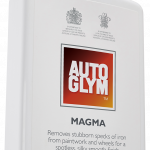
That rough feeling on a car’s paintwork? It’s a good chance that iron fallout is present and even a regular wash routine can’t hold back this destroyer of paint finishes forever.
Fallout is the collective description of anything that “falls” and settles on cars’ surfaces. Most fallout is iron contamination, since iron is one of the most common metals used in automotive, transport and industrial settings.
All cars will pick up fallout because apart from airborne debris from roadworks, construction, airports, railways and industrial areas, more than 60% comes from cars themselves – especially brakes – yours and others you meet on the road.
Some iron particles can be seen as small black dots on paintwork while others can’t be seen at all. You can feel them though, if you slip a plastic bag and run it gently across freshly washed paintwork.
If there’s no contamination, the bag will glide gently across the surface but if there is, you’ll feel every little bump.
So, once you’ve established it’s there, what to do about it?
First up, unless the goal is a full paint correction, you need a quality fallout remover that’s gentle on paint and won’t strip existing waxes or coatings.



Autoglym produce LIQUID CLAY in bulk, professional quantities and MAGMA for DIY application.
Both are formulated to re-oxidise the chemical bond between iron particles and the surface they’re attached to, which helps to release them.
Rodox chemistry provides the colour-change technology, which helps to visually mark fallout with a deep purple hue, and this also helps when applying the treatment, to know which areas are clear.
Both LIQUID CLAY and MAGMA are new tech that result in the same outcome as using a clay bar to remove contamination (such as the Autoglym SURFACE DETAILING CLAY KIT).

The difference is that a clay bar sheers surfaces to remove the fallout particle, and liquid products work to release the bond.
Once all fallout has been removed, it’s time to assess the paintwork surface for any blemishes, fine scratches or swirl marks that should be removed, prior to a more durable wax or ceramic coating treatment.






